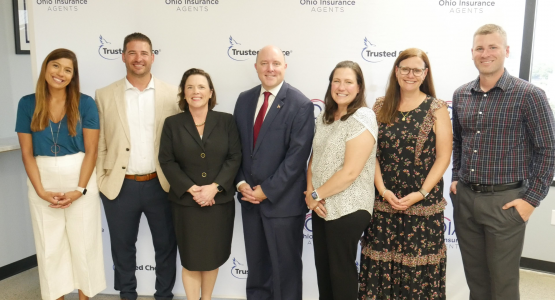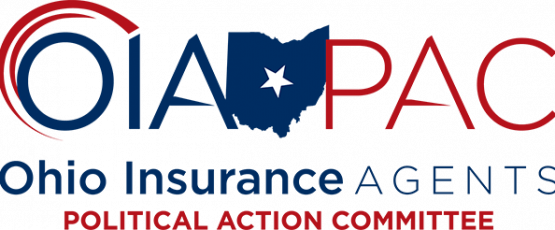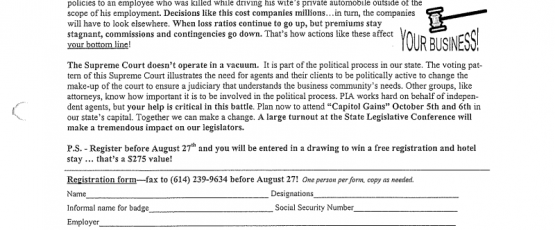Greater Transparency for Premium Increases and Extended Notification Time Period for Non-Renewals
As the new legislative session begins to take shape for 2025 – 2026, OIA is preparing a proactive advocacy agenda to make Ohio a better place for insurance policyholders, independent agents, and insurance companies to do business.
With Republicans maintaining control of all three branches of government: legislative, executive, and judicial, we anticipate a continued pro-business environment. This prospect is good for independent agents and their business owner clients as Ohio policymakers will focus on reducing tax and regulatory burdens on business owners.
In this article, we will preview OIA’s proactive advocacy agenda for the next session and opportunities for you to get involved in advocating for your clients, agency, and profession.
State Legislative Landscape
Republicans maintained their legislative supermajorities in the House (65-34) and Senate (25-8). Republicans have controlled the Ohio Senate since 1990 and the Ohio House since 2010. With the defeat of State Issue 1, the ballot initiative that would have restructured the way legislative and congressional districts are drawn, the GOP control of power is expected to continue for the foreseeable future.
There are two independent agents and OIA members serving in the Ohio House of Representatives – Rep. Brian Lampton and Rep. Jason Stephens. It is expected that Rep. Lampton will continue to serve as Chair of the Insurance Committee. Rep. Stephens ceded the Speaker’s gavel to incoming Rep. Matt Huffman, who also served as the Senate President.
Generally speaking, we anticipate a continued push towards lower state taxes for individuals and small businesses, elimination of the CAT tax, no new taxes on insurance premiums or commissions, and a reduction in regulations.
With insurance being a state-regulated business, it means there may be some additional opportunities to advance some potential issues like reducing regulations on agent licensing, the declination process for submitting E&S business, and opening up a private option for workers’ compensation (this would likely require a constitutional amendment).
Proactive Legislative Issues
Every legislative session, OIA’s Advocacy Committee and staff weigh in on issues that impact the IA system and insurance industry. Much of the time, OIA is playing defense thanks to the stability of Ohio’s insurance market, competitive environment, and reasonable laws and regulations.
The recent hard market is a further testament to the stability of Ohio’s insurance marketplace as Ohioans continue to enjoy home and auto premiums that are amongst the top 10 lowest in the country. That being said, 7 years of a continuous hard market has exposed some challenges in the insurance industry and Ohio’s regulatory structure. Therefore, OIA is preparing a proactive agenda for the 2025 – 2026 legislative session. The issues we plan to tackle include the following:
Increasing the Notification Time Period for Non-Renewals
In Ohio, insurance carriers are required to provide 30 days advance notice for non-renewal of insurance policies. In many other states around the country, the laws require a longer notice period, such as 45 to 90 days, to provide policyholders with ample time to find alternative coverage. Ohio’s 30-day notification period is among the lowest in the country and creates situations where agents and their clients do not have enough time to secure appropriate coverage for their risks.
Therefore, OIA is advocating for a 90 notification time period for the following reasons:
- Consumer Protection: Longer notice periods help protect consumers by giving them sufficient time to work with their agent on securing new insurance policies, compare coverages and rates, and avoid lapses in coverage.
- Complexity of Insurance: Finding a new insurance policy and carrier is a complex process, especially for specialized or high-value coverage. More time allows agents and their clients to make informed decisions.
- Market Stability: Longer notice periods can help maintain stability in the insurance market by preventing sudden shifts in coverage that could affect large numbers of policyholders simultaneously.
These measures are intended to balance the interests of both insurers and policyholders, ensuring that consumers are not left without essential coverage unexpectedly. In today’s hard market, carriers are making quick decisions to suspend and/or eliminate lines of business and other underwriting decisions that unexpectedly impact your client. With more advanced notice, agents could better ensure their clients have continuity of coverage are able to make informed insurance decisions.
Requiring Carriers to Provide Reasoning for Premium Increases Above 10%
As the risk advisor and closest to the consumer when making insurance decisions, the role of the insurance agent is to help their clients understand why and how premiums are charged for their risks. Unfortunately, with the changes to underwriting models, understanding and explaining premium increases have become increasingly more difficult.
Often, agents are left guessing as to why premiums have increased and worse yet cannot offer any logical explanation to their clients. The lack of transparency and information is not good for the insurance consumer, agent, or carrier.
Currently, ORC 3737.27 requires insurance carriers to provide 30 days advance notice of a “substantial” increase in premium for most commercial policies. We are advocating for the enactment of the NCOIL model law that has been adopted in Indiana, which requires insurance carriers to explain the principal factors for an increase in premium of over 10%, reduction in coverage, non-renewal, cancellation, or another unfavorable change in terms of coverage in connection with a personal auto or homeowner’s policy.
We will be working to identify legislators to lead this initiative for us in the next session. Please share your experiences with premium increases and lack of transparency as we look to build the case for enacting these changes.
Regulating Storm Scammer Contractors
Every insurance agent has multiple stories of an unannounced roofer showing up at their client’s house after a hailstorm offering to provide a free inspection. Next thing you know the roofer is on the roof with their tools removing shingles and offering to get your client a “free” roof replacement paid for by their insurance policy. Not all of these instances are fraudulent, however many do involve shoddy contractors looking to prey on vulnerable people after a storm.
In collaboration with other insurance industry advocates, OIA has been advocating for regulations to stop storm scammers. The regulations include:
- Requirements for any roofing contract exceeding $750 to be in writing and to include important information such as the contractor’s information, the contractor’s insurance coverage, an itemized description of the work to be done, an approximate total cost the consumer is expected to pay and prohibits a deposit of more than half the contract price.
- 3-day recission period – cooling off period after all parties sign the contract
- Prohibits the contractor from reporting, adjusting, or negotiating a claim on behalf of the consumer or receiving compensation for referring a claim to any person who reports, adjusts, or negotiates a claim on a consumer’s behalf.
We have testified multiple times in support of various legislative proposals over the years without success. We believe that the increasing number of CAT events and alleged contractor fraud will raise the need for the enactment of this law.
Establishing an Uninsured Motorists Verification System
In Ohio, it is estimated that 17.1% of drivers do not meet the financial responsibility requirements which is higher than the national average of 14%. In 2023, auto insurance premiums increased by approximately 14.3%, the highest in 15 years as insurers try to get back underwriting profitability, which appears they have in 2024. A portion of this increase is attributable to the increasing number of drivers on the roads without insurance coverage.
In addition, the increasing severity and frequency of crashes since the COVID-19 pandemic has been a major factor in driving up costs for insurance carriers. Tack on rising medical costs, an increase in stolen cars, more distracted driving, and higher legal costs, and it creates an environment of rising insurance premiums that need to be addressed piece by piece.
One piece of the puzzle is getting a better handle on uninsured motorists. Currently, Ohio lacks any modern and independent mechanism to proactively monitor whether drivers have insurance. Many states have adopted online insurance verification systems and have experienced success in reducing the number of uninsured motorists.
OIA is planning to advocate for reopening this issue with lawmakers in 2025 – 2026. We do not have an identified solution but believe policymakers need to have an open debate and come up with a solution that has a proven track record and best suits Ohio.
Opportunities for Agent Engagement
There are several ways agents can advocate for their clients, businesses, and professions with minimal time commitment. Opportunities include:
-
- OIA Advocacy Committee – comprised of 15 volunteer independent agents. This group meets virtually 3 – 4 times per year and takes positions on policy issues for the OIA.
- Federal Legislative Conference – hosted annually, OIA brings a delegation of 12 – 20 agents to Washington D.C. to advocate on Capitol Hill. At this conference, agents join approximately 1,000 agents from across the US to meet with members of the Ohio Congressional delegation, hear from leading policymakers, and dine with fellow agents and lawmakers. The conference is scheduled for April 30 – May 2. There are many scholarships available to offset the cost of registration, travel, and lodging.
- State Advocacy Day – hosted bi-annually, OIA’s volunteer leaders descend on the Statehouse in Columbus for a dinner with leading policymakers and a day of meetings with insurance-focused legislators and regulators. The State Advocacy Day is scheduled for June 10 – 11 2025. All agents are welcome to participate.
- Political Events – OIAPAC raises funds annually to support campaigns of public officials that support the IA system and insurance industry. The most effective way to distribute these resources is through local political events. If you are interested in attending local events on behalf of OIAPAC, please contact us.
Conclusion
OIA is the voice of Ohio’s independent agents at the Statehouse, Department of Insurance, and Courthouse. We are planning for an aggressive proactive advocacy agenda for the 2025 – 2026 legislative session. OIA is made up of approximately 1,000 independent agencies across Ohio, and the success of advocating for your clients, agencies, and profession is predicated on active engagement from the membership. If any of these issues or opportunities interest you, please contact OIA’s Executive Director Jeff Smith at jeff@ohioinsuranceagents.com so we can get you engaged in the issues that matter most to your business.

About the Author:

Jeffrey S. Smith, JD, CIC, CAE serves as Chief Executive Officer for Ohio Insurance Agents Association (OIA) and IA Valuations. He is responsible for leading the organization’s strategic initiatives and day-to-day operations.
As CEO of IA Valuations, Smith has consulted and reviewed over 200 agency valuations for independent agents across the US. IA Valuations serves independent agencies as a trusted advisor and strategic business partners as they implement strategies to increase their agency value, grow their businesses, and transition their agencies. Smith provides insights into the agency’s operations, risk factors, and legal guidance on how to perpetuate and maximize value in a sale.






